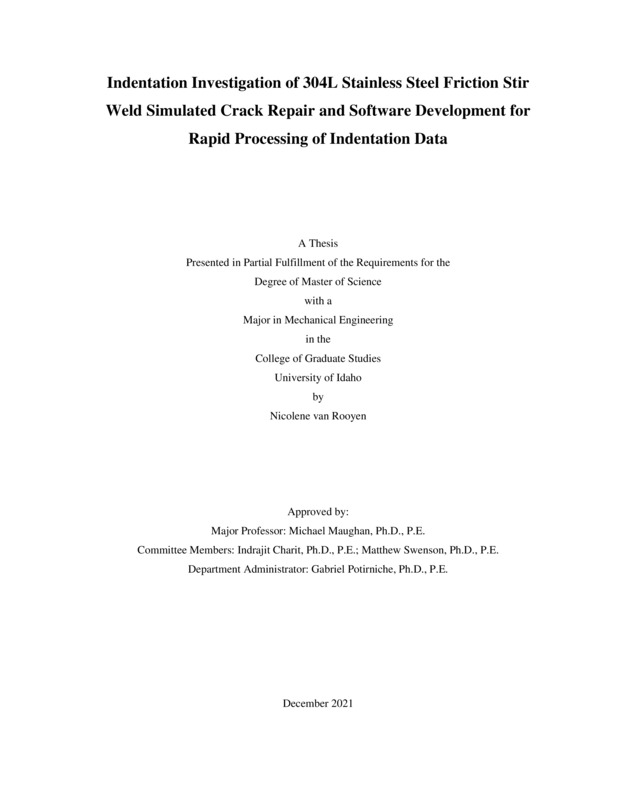Indentation Investigation of 304L Stainless Steel Friction Stir Weld Simulated Crack Repair and Software Development for Rapid Processing of Indentation Data
van Rooyen, Nicolene. (2021-12). Indentation Investigation of 304L Stainless Steel Friction Stir Weld Simulated Crack Repair and Software Development for Rapid Processing of Indentation Data. Theses and Dissertations Collection, University of Idaho Library Digital Collections. https://www.lib.uidaho.edu/digital/etd/items/vanrooyen_idaho_0089n_12247.html
- Title:
- Indentation Investigation of 304L Stainless Steel Friction Stir Weld Simulated Crack Repair and Software Development for Rapid Processing of Indentation Data
- Author:
- van Rooyen, Nicolene
- Date:
- 2021-12
- Keywords:
- Crystallographic Texturing Friction Stir Welding Nanoindentation Stainless Steel Vickers Hardness
- Program:
- Mechanical Engineering
- Subject Category:
- Mechanical engineering; Materials Science
- Abstract:
-
Simulated cracks were repaired in 304L stainless steel using low temperature friction stir welding. Indentation studies were carried out to understand the effect of microstructural features on the mechanical property variation across the weld and to measure the size of the weld zones with a quantitative technique. Microhardness and nanoindentation hardness profiles were constructed on a transverse section across the weld. The data obtained were correlated by extrapolating the nanoindentation hardness to greater depths which showed that the nanoindentation hardness closely reflects the microhardness values throughout the weld. Hardness contour maps, with adequate resolution, revealed that nanoindentation can detect material flow induced features, like: “lazy-S” and onion rings. Grain size in the stir zone (SZ) was found to vary with the tool temperature which, in turn, alters the nanoindentation modulus variability and higher tool temperature resulted in softening and widening of the SZ. Comparing nanoindentation elastic contour maps suggest that temperature significantly effects the crystallographic texture development across all zones of the FSW. Four data processing Graphical User Interfaces were developed, using Python, to process the raw data files of the microhardness and nanoindentation tests.
- Description:
- masters, M.S., Mechanical Engineering -- University of Idaho - College of Graduate Studies, 2021-12
- Major Professor:
- Maughan, Micheal
- Committee:
- Charit, Indrajit; Swenson, Matthew; Potirniche, Gabriel
- Defense Date:
- 2021-12
- Identifier:
- vanRooyen_idaho_0089N_12247
- Type:
- Text
- Format Original:
- Format:
- application/pdf
- Rights:
- In Copyright - Educational Use Permitted. For more information, please contact University of Idaho Library Special Collections and Archives Department at libspec@uidaho.edu.
- Standardized Rights:
- http://rightsstatements.org/vocab/InC-EDU/1.0/

